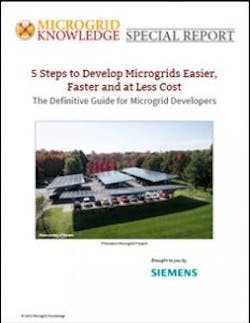How to Make Microgrid Hardware Choices: A Guide for Developers
In a new special report series brought to you by Microgrid Knowledge and Siemens, we’re providing a guide to help microgrid developers avoid the pain points that can wreck the financial and operational assumptions for a project. This fifth article in the series looks at microgrid hardware choices in Step 4: Managing Balance-of-Plant Considerations.
Download the full report.
Even after decisions on distributed energy resources and the microgrid controller are made, there remain numerous hardware decisions on items such as switchgear, busbars, breakers, inverters and panel boards.
Making the wrong “balance-of-plant” microgrid hardware choices leads to a number of additional development challenges. These can include increased costs on replacement orders or additional hardware to cover shortcomings, project delays stemming from implementing solutions to new problems and unfulfilled goals for customers if a system begins operating with suboptimal hardware.
Watch the Microgrid Knowledge webinar “Preventing Scope Gaps for Microgrid Developers: Steps to Develop Microgrids Easier, Faster, and Cheaper.”
One real life example of a balance-of-plant hardware choice gone wrong happened in California when a rental truck company sought to develop its own microgrid to manage an electric truck pilot project. The company purchased a battery and vehicle chargers from one vendor and chose a separate electrical contractor to install a switchboard. Unfortunately, the contractor did not set up a means to monitor and report the system’s energy use, meaning the company could not produce the time-of-use and self-generation reports needed to earn the rebates and incentives available in California that made the project economic. After the initial project was complete, the rental truck company had to find another vendor and pay additional costs to have new hardware installed to fix the issue.
Microgrid hardware choices become harder to get right if they are preceded by gaps in understanding project requirements, studies that don’t produce the necessary outputs or procurement of a control system that doesn’t fit project needs.
However, there are several key considerations to take into account when making critical microgrid hardware choices at this stage. Download the full report to get a checklist of 11 balance-of-plant considerations.
The list of balance-of-plant considerations provided in the full report is intimidating to be sure, which is why it’s so common for something simple like lack of equipment space in an older building to escape notice until the problem reveals itself and time and costs are already sunk. This makes it critical for developers to not only take the considerations outlined in the full report into account, but also seek guidance from trusted partners before making balance-of-plant choices.
For example, when a large multifamily residential building owner in Manhattan sought to install a microgrid with a battery storage system, the developer discovered that lithium batteries were not allowed inside the building and there was nowhere in the highly dense urban area outside the building to locate the system. Siemens helped develop an alternative approach to use a lead-acid battery array that could be located under the building’s parking lot.
Many of these unwelcome surprises emerge because it’s impossible for a developer to solve a problem it doesn’t know exists. However, they are avoidable. Ask the right questions and work with experienced partners who have “been there and done that” to get answers and avoid big surprises that can result from what seem like small balance-of-plant choices.
To learn more about 11 balance-of-plant considerations for microgrid developers, download the full report. And check out the previous articles in the series below:
Delivering on the Promise of Microgrids: A Guide for Microgrid Developers
Understanding Microgrid Project and Operational Requirements
The Importance of Microgrid Power Supply Studies
How to Make the Right Microgrid Procurement Decisions
Download the full report “5 Steps to Develop Microgrids Easier, Faster and at Less Cost: The Definitive Guide for Microgrid Developers,” courtesy of Siemens to learn more.
